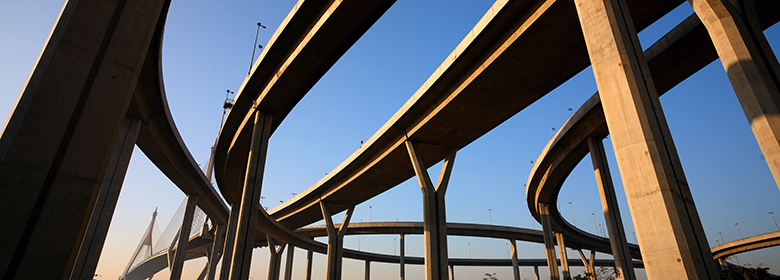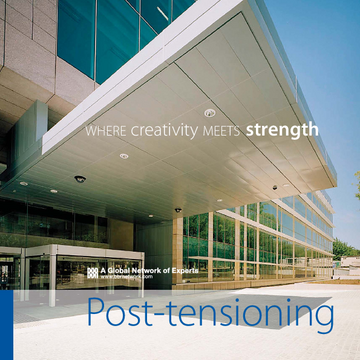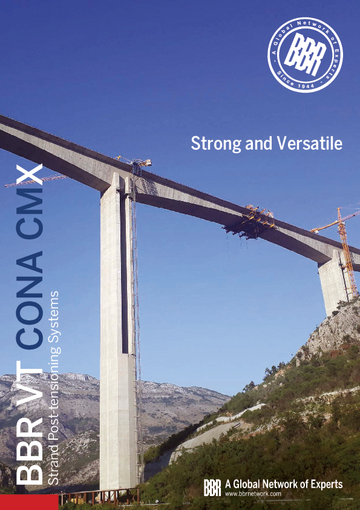What is post-tensioning?
An architect’s dream, a delight for developers, a great tool for builders and kind on the environment – post-tensioning allows almost any shape of structure to be constructed, while reducing environmental impacts, construction time, materials and costs. Since the first applications, PT technology has advanced significantly – particularly in the field of performance, quality assurance and durability as well as corrosion protection. But what exactly is it? And why should you be interested?
Q: What is post-tensioning?
A: At its most basic level, post-tensioning (PT) is a fiendishly clever way of reinforcing concrete while you are building – occasionally even allowing the construction of something which might otherwise have been impossible!
The use of post-tensioning allows thinner concrete sections, longer spans between supports, stiffer walls to resist lateral loads and stiffer foundations to resist the effects of shrinking and swelling soils. Concrete has what engineers call ‘compressive’ strength – meaning that it happily bears its own weight within a structure. As soon as you introduce the ‘live’ loads of everyday usage, such as vehicles in a car park or on a bridge, the concrete tends to deflect or sag which leads to cracking, thus weakening the structure.
Concrete lacks ‘tensile’ strength. Alone, it does not always offer the flexibility needed. That’s why steel reinforcing bars – ‘rebar’ – are often embedded in the concrete to limit the width of cracks. However, rebar provides only passive reinforcement – that is, it does not bear any load or force until the concrete has already cracked.
This is where post-tensioning comes in. PT systems provide active reinforcement. The function of post-tensioning is to place the concrete structure under compression in those regions where load causes tensile stress. Post-tensioning applies a compressive stress on the material, which offsets the tensile stress the concrete might face under loading. PT is applied by the use of post-tensioning ‘tendons’ – a complete assembly including the very high strength prestressing steel strands or bar, the sheathing or protective ducting, plus any grout or corrosion-inhibiting coating surrounding the steel strands or bar and the anchorages needed at both ends.
A typical steel strand used for post-tensioning has a diameter of 15.7mm and a tensile strength around four times higher than an average non-prestressed piece of rebar. Sheathing or ducting houses the prestressing steel This allows it to move as necessary when the tensioning force is applied after the concrete cures. The steel stretches as it is tensioned and it is locked into place using an anchoring component, thus maintaining the force in the strand for the life of the structure.
Q: Why should I be interested in post-tensioning?
A: There are many benefits to be gained by adopting a post-tensioned approach to construction including flexibility of design, faster construction program and lower material costs. Over the longer term, it can reduce maintenance costs and also offers the potential for increasing future loading or being adapted for a change of use.
Perhaps the most dramatic example of design flexibility is demonstrated by the use of post-tensioning for bridges where it allows very demanding geometry requirements, including complex curves, variable superelevation and significant grade changes. In stadiums, post-tensioning allows long clear spans and a highly creative architectural approach.
While for commercial buildings space and light can be maximized by construction of large column-free spaces. A faster construction program and lower construction material costs result from reduced quantities of concrete and steel being needed for the superstructure, but post-tensioning can also significantly reduce the amount of groundworks required. In addition, thinner PT slabs and early strength stressing promotes a faster floor cycle time, allowing the structure to progress more rapidly.
Over the longer term, post-tensioned structures attract lower maintenance costs. Take a warehouse floor slab, for example. A PT solution will deliver fewer joints and thus reduced joint maintenance – as well as long-term durability. Looking at tanks and silos, post-tensioning can provide virtually crack-free concrete. Going beyond this, PT structures can also be altered – rather than demolished – to accommodate changed use over time.
The use of post-tensioning promotes a more environmentally friendly approach to construction. In the first place, post-tensioned structures feature less construction materials – steel reinforcement, concrete – and thus create fewer carbon emissions in terms of production and transportation. The actual construction process can also be environmentally sensitive – for example, when constructing extremely long span PT bridges temporary intermediate supports are not needed, thus the impact on the environment beneath is minimized.
Q: What is a European approved post-tensioning kit?
A: A European approved post-tensioning kit comprises all elements that make up the complete PT tendon. CE-marked PT kits are only sold by certified Post-tensioning Specialist Companies who take the full responsibility for post-tensioning works.
In the past, there were a lot of national standards – for example, British or German DIN standards – and guidelines for testing provisions to which post-tensioning systems had to be subjected. Some countries adapted and adopted specifications for the acceptance of PT systems running in other countries, others did not have any acceptance criteria at all. Today, post-tensioning technology has a clear international passport if it bears the CE-mark and has secured the European Technical Assessment (ETA) for post-tensioning kits.
The CE marking and the European Technical Assessment for post-tensioning kits allow an accurate and are an up-to-date method of comparing like-with-like. From this, it is clear what specification the products fulfill, ensuring that all ETA systems provide the same minimum level of durability and safety. CE-marked post-tensioning systems installed by certified and responsible Post-tensioning Specialist Companies – such as Members of the Global BBR Network – provide the highest level of quality and ensure, for the owners of the structures to which the post-tensioning kits are applied, that only high quality and state-of-the-art products are being used.
Q: What types of PT are there?
A: The one-size-fits-all concept is no longer a viable one – optimization is needed to achieve the most environmentally-friendly structure. Opting to use post-tensioning means that a wider product range is available.
At BBR, we have now grouped our tendons so that you only use what you actually need. We offer more than 25 different sizes of multi-strand anchorages – ranging from 1 to 73 strands. All the size groups can be handled and stressed with just one piece of gear – the kit has been rationalized. In this way, we are helping to ensure that only the amount of anchoring material which is really needed goes into the structure, whilst minimizing additional transportation impacts for construction gear.
Post-tensioning tendons come in a number of varieties and cover a wide range of applications. There are four main types:
- Internal bonded tendons – where one or more strands are inserted into a metal or plastic duct that is embedded in the concrete. By filling the duct with special grout, the tendon is ‘bonded’ with the surrounding concrete. Internal bonded tendons are installed before concrete is poured and become locked in concrete. This approach is often used for bridges and heavily loaded beams in buildings – flat internal systems are also an excellent choice for thin slabs.
- Internal unbonded tendons – where the prestressing steel is not actually bonded to the concrete that surrounds it, except at the anchorages. They are used in slabs and slabs-on-ground for buildings and parking structures but also more and more in infrastructure projects.
- External unbonded tendons – these are installed on the outer surface of concrete structures. This type of post-tensioning allows access for maintenance and replacement, this is therefore the solution of choice for bridge enhancements and refurbishments.
- Ground anchors – these are used to stabilize sides of excavations, hillsides and tunnel walls. They are also used for resisting uplift for towers or seismic strengthening. CE-marked PT products are constantly under surveillance to ensure they continue to fulfill all requirements of their European Technical Assessment.
Q: How is PT installed?
A: The short answer is ‘easily’ – that is, by a Specialist Post-tensioning Specialist whose staff have completed the relevant training and have the backing of a major international organization.
Post-tensioned systems should only be designed and installed by PT Specialist Companies, such as those within the BBR Network. Designing the shape of the PT layout and specifying the right system is a vital stage in the process and requires sound engineering consideration in order to maximize the benefits for all the stakeholders in a project.
Work on applying the post-tensioning system can begin after any formwork or bottom reinforcement has been installed. Typically, for a bonded system, ducting will be laid out first, then strands will be installed with the help of a strand-pushing machine and end anchorages will be placed. But also off-site prefabrication of post-tensioning tendons can offer great benefits for certain construction projects.
Concrete placement follows next. When the concrete has attained its minimum strength, the strands are anchored in a common anchorage device and stressed with a large, multi-strand jack or mono-strand stressing tool. When the jack reaches the correct load, it releases the tendon. The tendon then retracts slightly, activating the anchoring system and creating a tight lock on the tendon. The anchor maintains the applied force in the tendon and transfers it to the surrounding concrete.
The duct is then filled with a cementitious grout that provides corrosion protection to the strand and bonds the tendon to the concrete surrounding the duct.
Q: Is PT a recent invention?
A: No, it’s been around for a long time! In fact, prestressed concrete has become the most widely used construction material for today's bridges and a growing number of residential, commercial and public buildings. BBR has led in this development and today thousands of projects worldwide contain BBR post-tensioning technology.
Almost as soon as reinforced concrete had been developed, at the end of the 19th Century, engineers recognized that its performance could be improved if the bars could be placed in tension – and keep the concrete in compression. However, it was not until much later that the use of post-tensioning for structures really became widespread.
BBR's long history of innovative development began in 1948, when the partnership patented the BBRV ‘button head wire’ post-tensioning system. Subsequently, BBR developed a complete range of prestressing and post-tensioning systems, ground anchors and stay cable anchorages, covering all structural engineering applications, and today, the BBR Network operates in over 50 countries around the globe.
Post-tensioning
Where creativity meets strength
See our Downloads pageBBR VT CONA CMX
A detailed overview of the extensive range of BBR post-tensioning systems.
See our Downloads pageBenefits of post-tensioning
- Greater flexibility of design
- Faster construction program
- Lower construction material costs
- Reduced maintenance costs
- Potential for increased future loading
- Improved whole life costs & durability
- Reduced environmental impact










